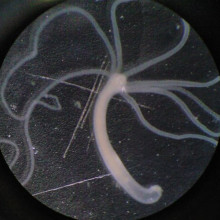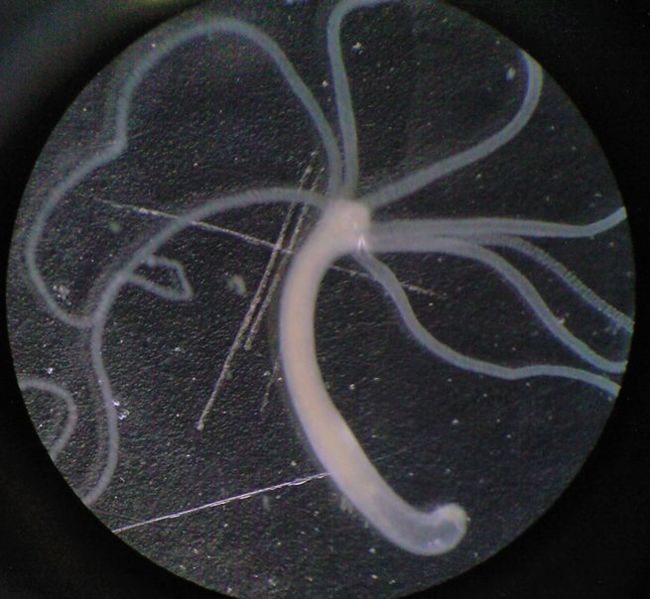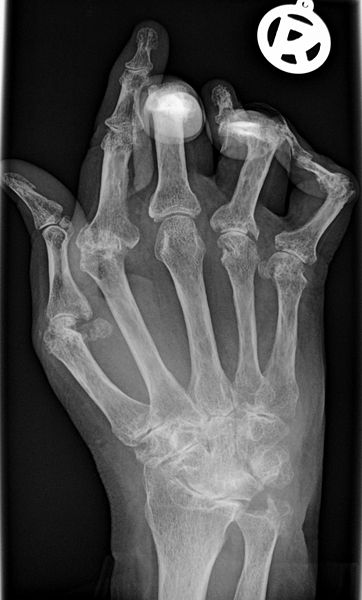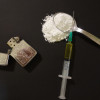This week, we find out why you should measure your broker's fingers before handing over any cash, discover a whole new family of proteins to help in the war against superbugs, and the methane on Mars - we know it's there, but what's making it? Find out on this Naked Scientists NewsFlash...
In this episode

01:34 - Fingers and Traders
Fingers and Traders
The length of your fingers determines whether you've got the Midas touch...
Scientists have revealed this week that the relative lengths of a persons' fingers can predict money-making ability on the financial markets. Cambridge University Judge Business School researcher John Coates and his colleagues, who also made headlines last year by showing that testosterone levels amongst city traders were linked to their daily profits, took photocopies of the palm-prints of 44 financiers. The researchers measured the lengths of the index and ring fingers to find a strong association between the finger length and profit or loss.
Traders with an index finger shorter than the ring finger were more successful, on average, and the larger the ring finger relative to the index finger - known as the 2D:4D ratio - the more money they made.
"This is an index of testosterone exposure during development," points out Coates. "Some of the same genes that control limb and hand development in the embryo are also involved in the development of the urogenital system, so finger length is an index of pre-natal testosterone levels. Testosterone therefore seems to pattern the body and behaviour later in life; we see the same relationship amongst sportsmen playing testosterone-charged sports."
In the present study the researchers looked at a specific group of traders who aim to profit by gambling on second-by-second and minute-by-minute fluctuations in the values of certain assets.
"These high frequency trades require the same testosterone-fuelled rapid reactions that benefit an athlete on the sportsfield," says Coates, "although not all financial roles benefit from high testosterone. Some money-making schemes require traders to take a much longer-term view and high testosterone is unlikely to be of benefit under those circumstances." So the bottom line is, when making short-term bets on stocks and shares, measure your brokers' fingers; ideally before you threaten to break them!

Miniature water creatures harbour antibacterial secrets
As you can read in any paper, there are big problems today with hospital-acquired infections - people picking up nasty bugs in hospital - along with antibiotic resistance, meaning we have fewer weapons in our fight against bacteria. So the search is on for new antibiotics.
 Now scientists at the university of Kiel in Germany have found an unexpected source of new bug-busters - tiny animals known as Hydra. These tiny creatures, just a few millimetres long, live in freshwater ponds and streams. Writing in the Journal of Biological Chemistry, Joachim Grötzinger and his colleagues have discovered a new protein in Hydra, which they've called hydramacin-1. And it has powerful anti-bacterial action.
Now scientists at the university of Kiel in Germany have found an unexpected source of new bug-busters - tiny animals known as Hydra. These tiny creatures, just a few millimetres long, live in freshwater ponds and streams. Writing in the Journal of Biological Chemistry, Joachim Grötzinger and his colleagues have discovered a new protein in Hydra, which they've called hydramacin-1. And it has powerful anti-bacterial action.
What makes hydramacin-1 unusual is that it isn't at all similar to most of the other anti-microbial proteins that scientists have previously discovered, and seems to be part of a new protein family. Looking at the 3-D structure of hydramacin-1, the team found that it is most closely related to a superfamily of proteins including some found in scorpion venom, and also two leech proteins. This is potentially powerful, as it means that it's a new angle to try in the war on bacteria.
Lab tests showed that hydramacin-1 could kill a wide range of different bacteria, including bugs called Klebsiella oxytoca, which are a common culprit in many hospital-acquired infections. The researchers found that hydramacin-1 works by sticking to the surface of bacteria, causing them to lump together, then breaking the bacterial cell membranes so they are killed.
Although this is a long way from being a commercial microbicide or treatment, it's yet another small step forward on the human front in our war on bugs.

Rheumatoid Arthritis B-Cell Breakthrough
A new discovery has shed light on the mechanism by which joints are damaged by rheumatoid arthritis, scientists announced this week.
 Writing in this week's edition of the journal PLoS Medicine Barts and the London Medical school researcher Constantino Pitzalis and his colleagues collected samples from the inflamed joints of patients affected by the disease, which affects about 1% of the adult population and occurs when the immune system mistakes healthy joints for hostile tissue and attacks them.
Writing in this week's edition of the journal PLoS Medicine Barts and the London Medical school researcher Constantino Pitzalis and his colleagues collected samples from the inflamed joints of patients affected by the disease, which affects about 1% of the adult population and occurs when the immune system mistakes healthy joints for hostile tissue and attacks them.
"What we have found is that a class of infection-fighting white blood cells, called B lymphocytes, make their way to affected joints where they set up structures called germinal centres. These function as antibody factories, producing antibodies that then attack the joint tissue," says Pitzalis.
To prove that this was the case the team injected immune cells from rheumatoid patients' joints into the skins of mice genetically programmed to lack an immune system of their own. For 90 days the team were able to detect the antibodies in the blood of these so-called SCID (Severe Combined Immuno-Deficiency) mice.
"This shows that the germinal centres are sufficient to produce the antibodies directly in the joint," Pitzalis explains.
Apart from providing new insights into the mechanisms of rheumatoid arthritis, which costs the NHS more than £1.2 billion per year to treat affected patients, the new research may also help with the development of better drugs and better use of the drugs we do have to control the disease.
"To stop the damage done by rheumatoid arthritis we need to selectively kill the B-cells making the rogue antibodies," says Pitzalis. "This animal model can help us to do develop cost-saving ways to do that."

Talking about post-natal depression
Post-natal depression affects a significant proportion of new mothers. Some studies suggest one in twenty may be affected, while others show it could be as high as one in four. Not only can this be a problem for the mother, but it can also have an impact on her child and its care, and in the worst cases can lead to women taking their own lives. New mums with post-natal depression may be offered anti-depressants, but many don't want to take them, especially if they're breastfeeding.
 Now researchers from the University of Toronto have discovered that talking things through with someone who understands what you're going through can cut the chances of post-natal depression by around half.
Now researchers from the University of Toronto have discovered that talking things through with someone who understands what you're going through can cut the chances of post-natal depression by around half.
Writing in the British Medical Journal, Dr Cindy-Lee Dennis and her team used a web-based tool to screen more than 21,000 new mothers in the Canadian province of Ontario, to find those who seemed to be at risk of developing post-natal depression. Then they recruited around 700 women, and divided them randomly into two groups. One group got standard post-natal care, while the other group got the same care, but also had telephone support from a volunteer who had also gone through post-natal depression.
The researchers found that the mums who got support over the phone had half the risk of developing depression three months after their birth than the women who just got standard care. And eight out of ten of them said they were happy with it, and would recommend it to a friend. Dr Dennis says that women and their families need to know more about post-natal depression, and that putting new mums at risk in touch with women who've been through it could be a significant way to help. But this needs doctors, nurses, midwives and other health professionals to be aware of the risks an symptoms, so they can offer the right support at the right time.

11:01 - Does methane on Mars mean life?
Does methane on Mars mean life?
Dr Mike Mumma, NASA Goddard Centre for Astrobiology
Chris - Tell me about this methane, how did you find it in the first place?
Mike - Well, we were searching for it since 1999, actually. We are using a spectroscopic technique from the summit of Mauna Kea which is a very high volcano in Hawaii, 14,000 feet, where unlike most of Hawaii it actually snows once in a while. In any case we started then and by 2003 we had actually detected the gas using a technique called infrared spectroscopy and looking for vibrational bands of methane and of water at the same time.
Chris - Why did you go looking for it in the first place?
 Mike - Of course, one would not expect to find methane on Mars because it's an oxidising atmosphere. Unless it were released very recently, otherwise the lifetime of methane would be too short to have a significant abundance in the atmosphere. The general view if methane is released it could only be coming from one or two potential sources: one being geochemistry of one or two kinds and the other being biology of one or two natures.
Mike - Of course, one would not expect to find methane on Mars because it's an oxidising atmosphere. Unless it were released very recently, otherwise the lifetime of methane would be too short to have a significant abundance in the atmosphere. The general view if methane is released it could only be coming from one or two potential sources: one being geochemistry of one or two kinds and the other being biology of one or two natures.
Chris - So you think that in the same way that the early Earth was populated by methanogens, bacteria that make methane and actually were quite beneficial to us because they warmed up the Earth and made it the propitious environment for other kinds of life like us to exist later, you think the same thing might be happening on Mars?
Mike - It very well could be. In fact, we can take a message from the deep biosphere below South Africa where scientists have discovered that there are bacteria down there which actually metabolise in total absence of sunlight. They use radiolysis to break water into molecular hydrogen and oxygen and then the bacteria basically eat that hydrogen and use a gas called hydrogen sulphide as a result. It's not a great stretch to imagine that a methanogen might exist in the environment in Mars and using energy from radiolysis at least and then excreting methane which is then released into the atmosphere.
Chris - So having identified the fact that you've got this methane signal in the atmosphere around Mars how did you then further develop the investigation to try and work out where it was coming from?
Mike - We used a spectrometer that has a long entrance slit and we placed that slit along the north-south meridian of the planet, the midline dividing east and west hemispheres. Then we take 50 spectra at 50 locations along the slit and a cadence of every 60 seconds. So every sixty seconds we get a new set of spectra. Depending on how we combine those spectra we can choose the range of longitudes that will pass under the slit during the interval. For example, in the case of a 5 or 6 hour interval Mars will rotate approximately 60-80 degrees of longitude in that time. This way we can then later convert the measured spectra taking latitude from the top and bottom of the slit and longitude with time and develop a map of methane.
Chris - So the planet effectively, because it's rotating, surveys itself which is very convenient. What did this tell you? What did you see?
Mike - The big surprise was not just that we had detected methane but actually we see three regions of active release which are fairly closely grouped, to within 500,000km of one another. One region is over the district called Nili Fossae. This is a canyon system which is known to be a site where phytosilicates - clay minerals that form in liquid water - and also carbonates are found by Mars Express and also by an instrument on the Mars observer craft. What's interesting is that this is also a region of intense release of methane. Of course methane could be associated with water early in Mars' history or even now below the surface.
Chris - Is the release that you're seeing constant? Are you continuously seeing methane pumping out or does it come in spurts?
Mike - In fact it does not come out continuously. We find that between midsummer in the north when we see the maximum release and the next equinox season the methane is largely destroyed by a factor of 2 on Mars by a process we think is related to airborne dust. This methane is being released now in midsummer in the north. That's what we reported this week. Indeed, we think this is a very important window into an active Mars which we had not had before.
Chris - So the obvious question is now you've got two choices. It's either life or it's not life, it's something geological. You've gotta answer that question, how are you going to do it?
Mike - Well, we've started the test of these two hypotheses. One is to look for geological gases which would accompany either a geochemical production or biological production. So we've started a deep search for those gases in 2006. Unfortunately that's the season of equinox when we don't see the methane ever. They weren't so meaningful then so we'll be beginning again this fall, August 2009, at the very large telescope.









Comments
Add a comment